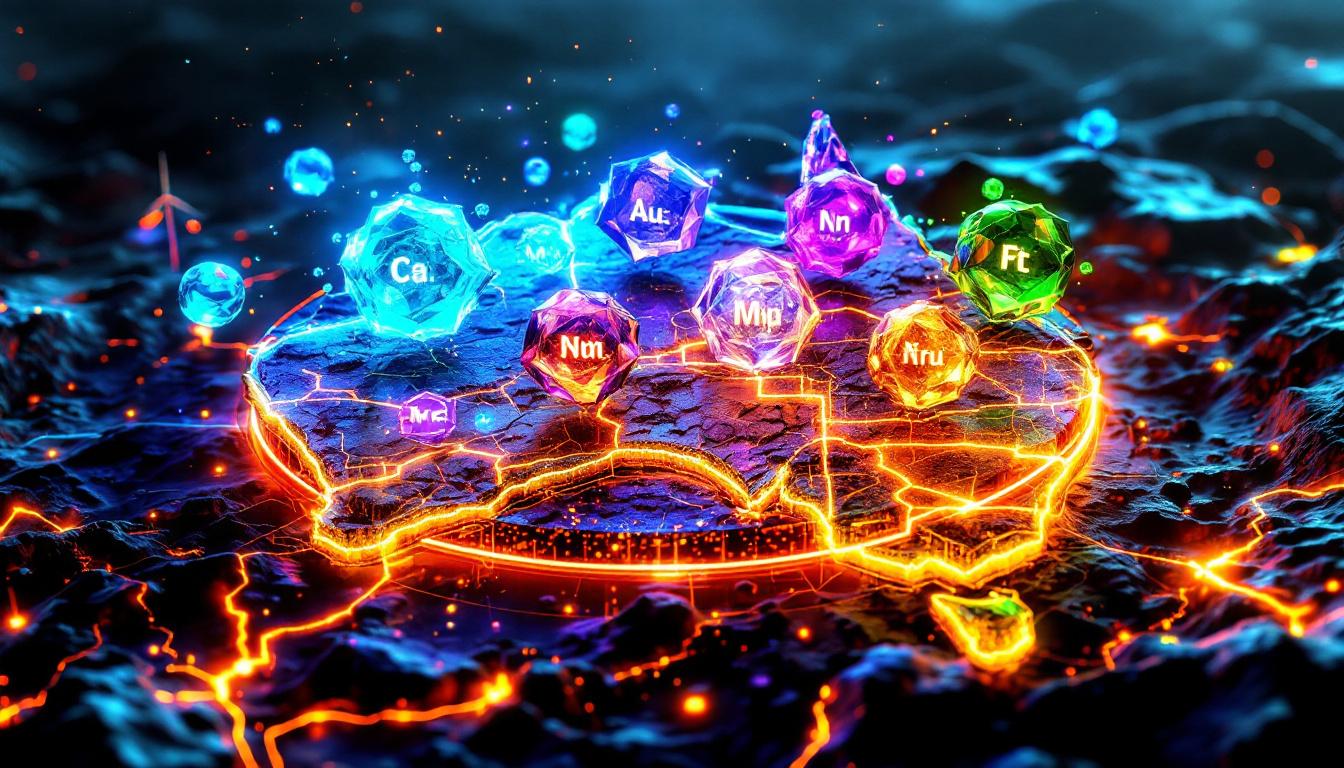What Drives Precious Metals During Trade Tensions?
Trade wars between major economies create significant ripple effects across global markets, with precious metals often serving as key beneficiaries during these periods of heightened uncertainty. The relationship between trade conflicts and metals like gold and silver is multifaceted, involving both macroeconomic factors and supply chain disruptions.
The Safe Haven Effect During Economic Uncertainty
When trade tensions escalate between major powers like the United States and China, investors typically seek refuge in assets perceived as stores of value. Gold, in particular, benefits from this "flight to safety" mentality for several reasons:
- Currency devaluation concerns: Trade wars often lead to competitive currency devaluations, making physical assets more attractive
- Inflation hedging: Tariffs and supply disruptions can drive up prices of consumer goods
- Reduced confidence in equities: Market volatility pushes investors toward traditional safe havens
"Gold has historically performed well during periods when geopolitical tensions create economic uncertainty, with prices often reaching new highs as investors seek portfolio protection," notes Kai Hoffman in a VRIC Media YouTube interview (2025).
The statistics paint a clear picture of this dynamic: China currently holds approximately $760 billion in U.S. Treasury bonds, giving it significant leverage in trade negotiations. This economic interdependence creates a complex backdrop against which precious metals operate as neutral assets outside the direct control of either party.
Central Bank Responses to Trade Conflicts
Central banks typically respond to trade-induced economic slowdowns by implementing accommodative monetary policies:
- Interest rate reductions: Lower rates decrease the opportunity cost of holding non-yielding assets like gold
- Quantitative easing: Expanded money supply can devalue currencies, boosting precious metals
- Foreign reserve diversification: Central banks themselves often increase gold purchases during trade conflicts
The technical aspects of central bank policy responses are particularly noteworthy. Quantitative easing programs involve the purchase of government bonds and other securities, which increases the monetary base and can lead to currency devaluation. This process typically unfolds over 6-18 months, creating a lagged but powerful tailwind for gold price forecast.
"China's resource positioning gives them negotiation power…they don't have to report quarterly results like Western companies," explains Hoffman, highlighting how state-backed resource companies operate with different timelines than their Western counterparts.
How Are Global Supply Chains for Precious Metals Affected?
Trade wars don't just impact demand for precious metals—they can fundamentally alter supply dynamics through various mechanisms. The disruption often begins at the resource level and cascades through processing, refining, and manufacturing.
Resource Nationalism and Strategic Controls
During trade conflicts, countries increasingly view their mineral resources as strategic assets:
| Country | Strategic Metal | Control Mechanism |
|---|---|---|
| China | Rare Earths | Export restrictions |
| Russia | Palladium | Potential export limits |
| United States | Critical minerals | Domestic production incentives |
| Various African nations | Gold, cobalt | Resource nationalism policies |
These control mechanisms can significantly impact global supply chains, creating bottlenecks and price premiums for affected metals. China's dominance is particularly striking, as it controls approximately 80% of global rare earth processing (U.S. Geological Survey, 2024 Mineral Commodity Summaries).
The Democratic Republic of Congo (DRC) presents another critical example, producing 70% of global cobalt (Cobalt Institute, 2024). As Hoffman notes, "China protected Kamoa-Kakula with financing while US countered with security deals in DRC," highlighting how major powers compete for access to strategic resources through different leverage points.
Mining Project Development Challenges
Trade tensions create several challenges for developing new mining projects:
- Equipment cost increases: Tariffs on mining machinery and processing equipment
- Financing difficulties: Economic uncertainty makes capital raising more challenging
- Regulatory hurdles: Increased scrutiny of foreign investment in mining projects
- Supply chain disruptions: Difficulties securing necessary inputs and components
These challenges are reflected in current market data showing that 62% of 2025 mining financings were under $2 million (S&P Global Market Intelligence), substantially limiting the sector's ability to develop new projects. This creates a potential supply deficit that could drive prices higher in the medium term.
Case Study: China's Resource Leverage
China's position in global resource markets provides significant leverage during trade negotiations:
- Controls approximately 80% of global rare earth processing capacity
- Produces substantial quantities of gold that remain within its borders
- Has established resource partnerships across developing economies
- Maintains significant holdings of U.S. Treasury bonds
The technical complexity of rare earth processing is a major barrier to supply chain diversification. Establishing new processing facilities requires $500 million to $1 billion in capital investments with 10-15 year development timelines (US Department of Energy, 2023). This creates a substantial first-mover advantage that China has successfully leveraged.
A practical example of this dependency can be seen in the automotive sector, where U.S. automakers are exporting engines to China for rare earth magnet installation before re-importing them (Wall Street Journal, May 2025). This circular supply chain demonstrates the intricate dependencies that US‑China trade war impact can disrupt.
Which Precious Metals Perform Best During Trade Wars?
Different precious metals respond uniquely to trade war dynamics, creating varied investment opportunities. The performance divergence can be substantial, offering sophisticated investors opportunities for tactical allocation.
Gold: The Traditional Trade War Beneficiary
Gold typically experiences the most direct positive impact from trade tensions:
- Historical performance: Gold prices have risen during most major trade conflicts
- Central bank buying: Institutional purchases accelerate during economic uncertainty
- ETF inflows: Investment vehicles see significant capital inflows
- Mining equity performance: Gold producers often outperform the broader market by 2-3x during these periods
The performance data is compelling: gold prices have increased 28% year-to-date in 2025, while the GDXJ (Junior Gold Miners ETF) has surged 62.5% (Bloomberg, June 2025). This demonstrates the leveraged exposure that mining equities can provide to the underlying metal.
Gold's molecular properties contribute to its unique role during trade wars. Unlike industrial metals, gold doesn't oxidize or degrade, making it ideal for long-term wealth preservation. Its high density (19.3 g/cm³) also means significant value can be stored in a compact form—a physical characteristic that has supported its monetary role for millennia and helped drive gold price highs analysis.
Silver: The Delayed Reactor
Silver presents an interesting case study in trade war dynamics:
- Industrial/precious hybrid: Silver's dual nature creates competing pressures
- Delayed response pattern: Often lags gold's initial moves but can provide greater leverage later
- Supply constraints: Trade restrictions can impact the 60% of silver production that comes as a byproduct of other mining
- Technical price barriers: Key resistance levels (such as $35/oz) can create significant momentum when broken
"Silver often lags gold but offers greater leverage when $35/oz resistance breaks," explains Hoffman in the VRIC Media interview. This technical analysis perspective highlights how chart patterns and price levels can influence investment flows in the silver market squeeze.
A critical supply factor often overlooked is that 60% of silver production comes as a byproduct of base metal mining (Silver Institute). This means that trade disruptions affecting copper, lead, and zinc production indirectly impact silver supply, potentially creating scarcity even when silver isn't directly targeted by trade measures.
Platinum Group Metals: Supply Chain Vulnerabilities
Platinum and palladium face complex trade war dynamics:
- Concentrated production: South Africa and Russia dominate global supply
- Automotive demand sensitivity: Vehicle production disruptions can reduce demand
- Substitution effects: Manufacturers may switch between metals based on availability
- Recycling economics: Trade barriers can impact the economics of metal recovery
The substitution dynamics between platinum and palladium are particularly notable, with a palladium substitution elasticity in autocatalysts of 0.7 (Johnson Matthey, 2024). This means manufacturers can switch approximately 70% of their palladium usage to platinum if price differentials or supply constraints make it economical to do so.
How Can Investors Position for Trade War Scenarios?
Investors have multiple options for gaining exposure to precious metals during trade conflicts, each with distinct risk-reward characteristics and implementation considerations.
Physical Metal Ownership vs. Paper Investments
Each approach offers distinct advantages and considerations:
| Investment Type | Advantages | Considerations |
|---|---|---|
| Physical bullion | Direct ownership, no counterparty risk | Storage costs, insurance, potential premium over spot |
| ETFs/ETPs | Liquidity, ease of trading, no storage concerns | Management fees, potential tracking errors |
| Futures contracts | Leverage, efficient capital deployment | Rollover costs, margin requirements |
| Mining equities | Operational leverage, dividend potential | Company-specific risks, jurisdiction concerns |
The mining equity sector has evolved significantly, with the average 2025 mining equity financing at $4.5 million versus the 2011 peak of $8.5 billion (TMX Group data). This represents a dramatic shift in capital availability and highlights the challenges facing junior explorers.
"Balance sheet strength becomes critical when trade wars disrupt financing," warns Hoffman, emphasizing how challenging markets can become for companies without sufficient cash reserves or production revenue.
Mining Company Selection Criteria During Trade Tensions
When evaluating mining investments during trade wars, several factors become particularly important:
- Jurisdiction diversification: Companies operating across multiple countries reduce political risk
- Balance sheet strength: Low debt levels provide resilience during market volatility
- Production costs: Lower-cost producers maintain profitability even if metal prices fluctuate
- Project pipeline quality: High-grade, permitted projects in safe jurisdictions command premiums
The Fraser Institute Annual Survey provides a sophisticated methodology for assessing mining jurisdiction risk, incorporating factors like regulatory uncertainty, tax regimes, infrastructure quality, and security concerns. This data-driven approach can help investors quantify geopolitical risks that become heightened during trade conflicts.
Strategic Allocation Approaches
Sophisticated investors often implement tiered allocation strategies:
- Core holdings: Established producers with strong balance sheets (50-60% of allocation)
- Mid-tier growth: Developing producers with production growth profiles (25-30%)
- Exploration exposure: Earlier-stage companies with discovery potential (10-15%)
This balanced approach provides both stability and upside potential across various market conditions. During trade wars and precious metals market fluctuations, the weightings might shift more heavily toward tier 1 producers with operations in stable jurisdictions, while maintaining a smaller allocation to higher-risk, higher-reward junior explorers.
What Are Current Trade Tensions Signaling for Precious Metals?
Recent developments in global trade relations provide important context for precious metals investors. The shifting alliances and emerging economic blocs have profound implications for resource markets.
US-China Relations and Resource Implications
The evolving relationship between the world's two largest economies has significant implications:
- Tariff implementations: Direct impacts on manufacturing costs and supply chains
- Technology transfer restrictions: Affecting critical mineral needs for advanced manufacturing
- Strategic competition: Increased focus on resource security and control
- Debt dynamics: China's holdings of U.S. Treasury bonds create complex interdependencies
Simon Hunt, cited in the VRIC Media interview, states that "US-China tensions will inevitably come to a head over critical materials." This expert assessment highlights how resource access has moved to the center of geopolitical competition.
Copper prices have fluctuated dramatically from $4.00 to $5.20 per pound during 2025 trade tensions (London Metal Exchange data), demonstrating how industrial metals can experience greater volatility than monetary metals like gold during trade conflicts. Furthermore, tariffs' market impact extends beyond just direct price effects to influence investment patterns across asset classes.
Regional Trade Bloc Formation
Beyond bilateral tensions, the formation of regional trade blocs is reshaping resource flows:
- East Asian integration: China, Japan, and South Korea developing closer economic ties
- Belt and Road Initiative: Creating resource corridors across developing economies
- Resource diplomacy: Strategic investments in mining projects across Africa and Latin America
- Processing capacity development: Countries competing to establish refining capabilities
Saudi Arabia has allocated $15 billion to mineral infrastructure in its Vision 2030 update (SAGIA, 2025), demonstrating how even traditional oil powers are diversifying into critical minerals as part of broader economic transformation plans.
"Processing partnerships let nations bypass sovereign risk," explains Hoffman, highlighting a sophisticated strategy where countries secure processing capacity rather than direct mine ownership to ensure resource access while minimizing political exposure.
Critical Mineral Supply Chain Restructuring
Trade tensions are accelerating efforts to secure supply chains for strategic minerals:
- Rare earth processing: Efforts to establish capacity outside China
- Battery metal sourcing: Partnerships forming to secure lithium, cobalt, and nickel
- Precious metal refining: Development of alternative processing hubs
- Technology metal recovery: Increased focus on recycling and urban mining
The MP Materials-Saudi rare earth venture (Company press release, Q2 2025) represents a significant development in reducing China's monopoly on rare earth processing. This partnership combines U.S. mining expertise with Saudi capital to establish processing capacity outside Chinese control.
Blockchain adoption is revolutionizing mineral supply chain transparency, with a 42% adoption rate among major miners (Deloitte Mining Report 2025). These systems allow for verification of origin, processing path, and compliance with trade regulations—increasingly important as trade restrictions target specific countries or production methods.
How Are Mining Companies Adapting to Trade War Realities?
The mining sector is implementing various strategies to navigate trade tensions. These adaptive approaches focus on both operational resilience and strategic positioning.
Jurisdiction Diversification Strategies
Companies are increasingly focusing on political risk management:
- Portfolio balancing: Maintaining assets across multiple countries
- Processing flexibility: Developing ability to direct concentrate to different refineries
- Ownership structures: Creating joint ventures to mitigate nationalization risks
- Local partnerships: Engaging with domestic stakeholders to reduce political exposure
Barrick Gold's portfolio rebalancing (2024 Annual Report) provides a case study in this approach, with the company strategically shifting investment toward Tier 1 jurisdictions while maintaining some exposure to higher-risk/higher-reward frontier regions through joint venture structures.
The Alphamin tin mine ownership shifts in DRC (Company ASX filing, June 2025) demonstrate how companies are adapting to changing political landscapes by bringing in local partners and government entities as stakeholders. This approach aligns corporate interests with host country objectives, reducing expropriation risk.
Capital Allocation Shifts
Trade tensions are influencing how mining companies deploy capital:
- Brownfield focus: Expanding existing operations rather than developing new projects
- Vertical integration: Securing downstream processing capacity
- Technology investments: Reducing labor dependence through automation
- Balance sheet strengthening: Maintaining financial flexibility for opportunistic acquisitions
First Majestic Silver's production cost reductions (Q1 2025 earnings report) exemplify how companies are focusing on operational efficiency to maintain profitability despite volatile metal prices. Their implementation of automated haul trucks and AI-optimized processing has reduced all-in sustaining costs by 18% year-over-year.
The technical aspects of cobalt refining involve specific hydrometallurgical processes vulnerable to trade restrictions (Journal of Sustainable Metallurgy, 2023). Companies are investing in proprietary refining technologies to reduce their dependence on external processors who might be affected by trade measures.
Corporate Identity Evolution
Some major mining companies are repositioning their corporate identities:
- Commodity diversification: Expanding beyond traditional focus areas
- ESG emphasis: Highlighting responsible production practices
- Technology integration: Positioning as materials solution providers rather than pure miners
- Strategic partnerships: Forming alliances with technology and manufacturing companies
This transformation reflects a sophisticated understanding that mining companies must adapt not just operationally but also in terms of how they communicate their value proposition to investors, regulators, and host communities.
What's the Long-Term Outlook for Precious Metals in a Fragmented Trade Environment?
Looking beyond immediate market reactions, several structural factors will influence precious metals in a world of persistent trade tensions.
Central Bank Reserve Diversification Trends
Official sector activities are evolving in response to geopolitical realignments:
- Reduced dollar dependence: Many central banks actively diversifying reserves
- Gold accumulation: Record central bank purchasing in recent years
- Regional currency arrangements: Development of alternatives to dollar-based trade
- Digital currency initiatives: Potential impacts on traditional monetary metals
This shift represents perhaps the most fundamental change in the international monetary system since the collapse of the Bretton Woods agreement. The accumulation of gold by central banks signals a hedging strategy against currency volatility and geopolitical uncertainty.
Industrial Demand Evolution
Manufacturing patterns are shifting in response to trade barriers:
- Reshoring initiatives: Moving production closer to end markets
- Supply chain redundancy: Creating multiple sourcing options for critical components
- Technological substitution: Developing alternatives to restricted materials
- Recycling emphasis: Increasing recovery rates for scarce metals
The technical complexity of establishing rare earth
Ready to Stay Ahead of the Next Major Mineral Discovery?
Discover significant ASX mineral discoveries in real-time with Discovery Alert's proprietary Discovery IQ model, transforming complex mineral data into actionable insights for short and long-term investing. Explore why major mineral discoveries can lead to substantial market returns by visiting our dedicated discoveries page and begin your 30-day free trial today.




